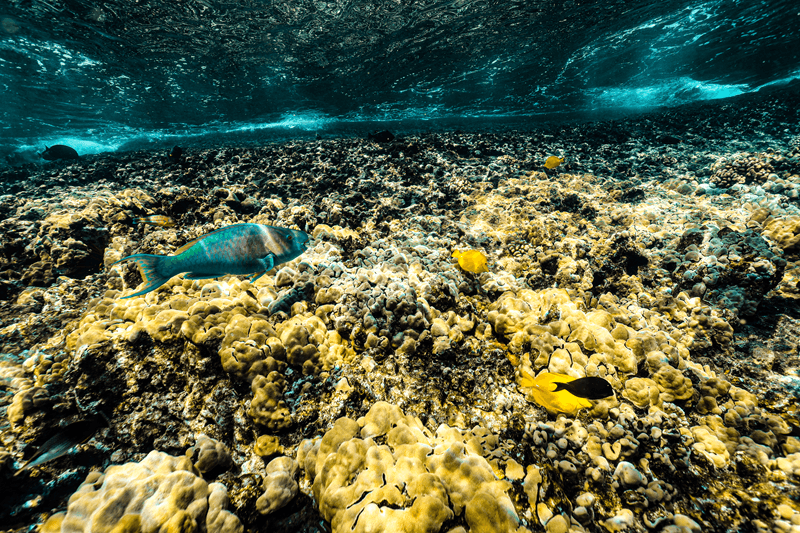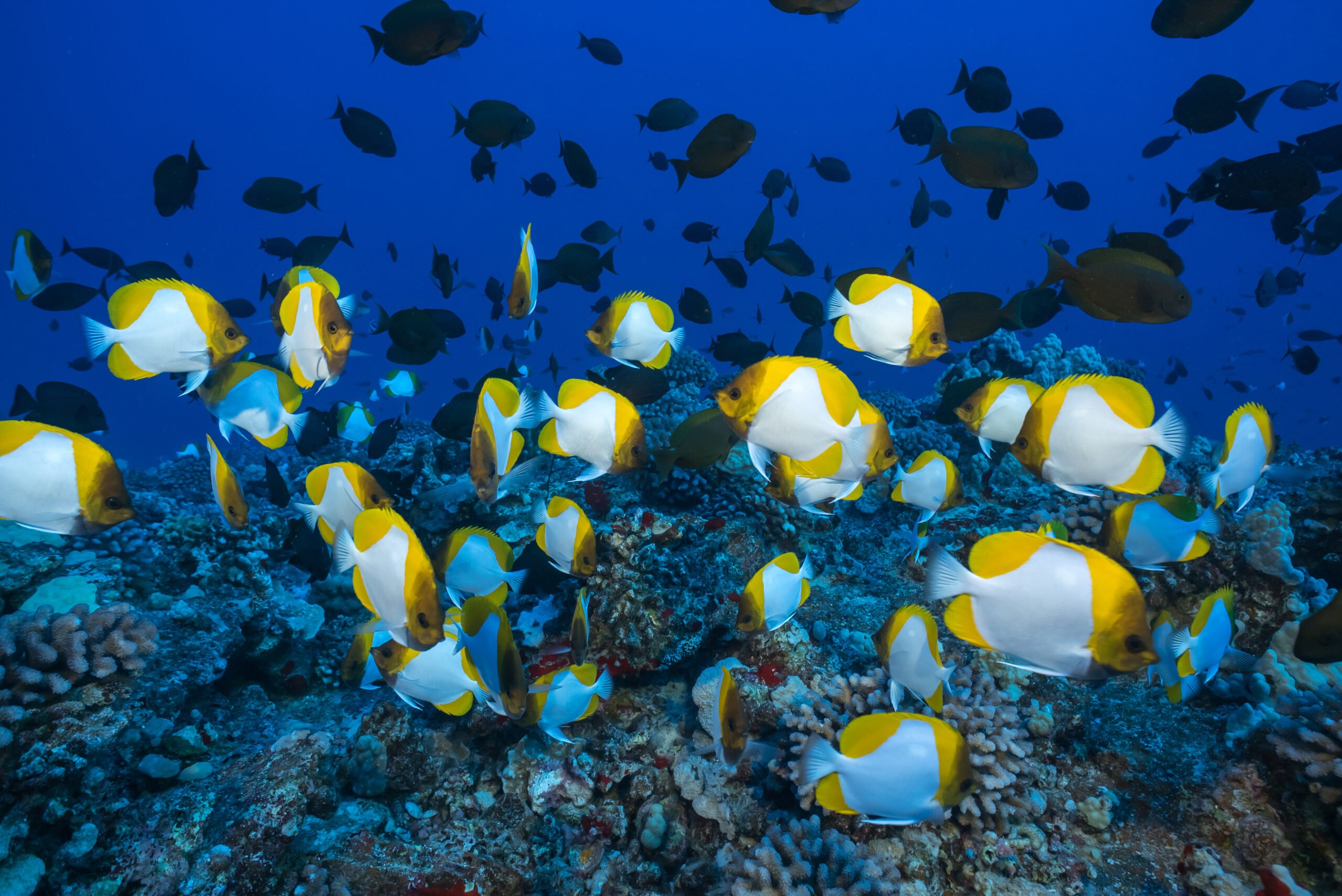Ever wondered what lies beneath Maui’s turquoise waves? Picture colorful coral gardens, coral colonies bustling with marine species, sea anemones waving gently, and schools of fish darting through sunlight. Maui coral reefs aren’t just beautiful — they’re alive.
Think of them as underwater neighborhoods built by tiny coral polyps that grow together to form reef-building corals. Each individual coral contributes to the island’s living reef structure made of calcium carbonate, creating safe havens where countless creatures depend on reefs for food and shelter.
These coral reef ecosystems are among the most biodiverse on Earth — even comparable to the reefs in the Caribbean — yet each one around Maui has its own unique rhythm and character.
Below you’ll find a guide to the reef types found across Hawaiʻi and where to see corals live on Maui without harming it. If you’re choosing snorkel spots, head to our Best Places to Snorkel in Maui guide for site-specific recommendations.
Maui Coral Reefs
Coral reefs also provide critical benefits to people. The many services provided by the world’s coral reefs include food, tourism income, and natural protection from storms — values that even developed countries rely on. Healthy coral cover helps buffer shorelines and supports sustainable fisheries. Because of their importance, scientists and local communities are working hard to restore damaged reefs and monitor bleaching events that threaten these habitats.
Unfortunately, coral bleaching from rising ocean temperatures continues to affect reefs globally. Warmer water stresses reef-building corals, forcing them to expel the algae they depend on for energy. If conditions improve, some can recover; others die, leaving behind bare skeletons that reduce total coral cover. But hope remains — restoration efforts across Maui show that with protection, water, coral reefs can rebound.
Reef 101: Types You’ll See in Hawaiʻi
Ready to become a mini marine geologist? Let’s explore the reef types you’ll spot when you strap on your snorkel and fins.
1. Fringing Reefs: These reefs grow right off the shoreline — the most common type in Hawaiʻi and around the world. You’ll often swim above them just steps from the beach.
2. Barrier Reefs: These sit farther offshore and are separated from land by a lagoon (think Australia’s Great Barrier Reef). Hawaiʻi has very few true barrier reefs; Maui has none.
3. Patch Reefs: Also known as “coral heads” or “bommies,” these are isolated patches of coral in shallow water, usually between the shore and a reef edge.
4. Atolls: Ring-shaped reefs surrounding a central lagoon — common in the Northwestern Hawaiian Islands, not near Maui.
Note: According to the NOAA Ocean Service, there are three main types of coral reefs, with fringing reefs being the most common.
What Maui Actually Has (and Why)
Most of Maui’s coral reefs are fringing reefs and live on the sunny south and west sides, where gentle waves let coral flourish. You’ll spot patchy ‘coral heads’ in calm coves — tiny underwater villages of marine life!
On Maui, most live coral growth concentrates along the leeward west and south coasts, where surrounding islands block surf; reef growth is limited on the windward northeast coast due to wave exposure.
Where to See Living Reefs on Maui
You’ll want to snorkel in the morning. Conditions are typically calmer with better visibility; afternoons often bring wind and chop. Follow Hawaiʻi Ocean Safety’s guidance.
These are spots to observe coral ecosystems and understand their importance. If you’re choosing snorkel sites, use our Best Places to Snorkel in Maui guide. Grab your goggles and let’s take a tour of some of Maui’s best underwater real estate:
Olowalu (“Turtle Reef”) — West Maui
Often called Maui’s largest fringing reef, Olowalu spans a mapped ~11.2 km² (≈2,770 acres) of reef extent from the shoreline to ~1.8 km offshore, with the shallow fringing footprint widely cited at ~800–939 acres depending on how it’s defined.
Why it’s special: ancient coral heads and critical larval “source” function — but please avoid standing or touching the reef.
Honolua–Mokulē‘ia MLCD — Northwest Maui
A Marine Life Conservation District (MLCD) with strong protections and no-take rules. This protected bay is an outstanding example of reef structure in a calm, scenic cove. Always check posted rules and access updates.
Molokini Shoal MLCD — Offshore South Maui
This crescent-shaped volcanic crater is surrounded by thriving coral communities. Commercial snorkeling and diving at Molokini operate under DLNR permits, and vessels must use day‑use moorings—anchoring is prohibited within the Molokini Island Day‑Use Mooring Area (HAR 13‑257‑56).
Public landing on the islet is not allowed because it’s a State Seabird Sanctuary; tours snorkel by boat only. Considering Black Rock vs. Molokini? See our side‑by‑side breakdown.
Tip: Join our Molokini Crater Tour for a safe and eco-friendly experience.
‘Āhihi-Kīna‘u Natural Area Reserve — South Maui
A lava-rock coastline filled with fringing and patchy coral growth. The area is heavily protected with posted hours and visitor limits — please follow signage and stay off coral.
Kahekili Herbivore Fisheries Management Area — Kā‘anapali
Inside the Kahekili Herbivore Fisheries Management Area, it’s illegal to injure, kill, possess, or remove parrotfishes (Scaridae), surgeonfishes (Acanthuridae), chubs/sea chubs (Kyphosidae), or any sea urchins; fish feeding is also prohibited.
⚠️ Conditions Change Daily
Swell, wind, and visibility vary by season and weather. Always check local advisories and follow posted signs before entering the water.
Join Our Tour!
Ride the slide into the fun, and discover the magical world of beautiful coral and other marine life!
Visit Reefs Responsibly (Rules That Matter)
Every little action helps our reefs thrive! Here’s how you can be a reef hero:
- Use Mineral‑only sunscreen in Maui County (sale, distribution, and use) — Ordinance 5306, effective Oct 1, 2022.
- Statewide Ban: Oxybenzone and octinoxate sunscreens were banned under Act 104 (2018), effective 2021.
- It’s illegal statewide to take, break, stand on, or otherwise damage stony corals or live rock (HAR 13‑95). Even light contact can kill living tissue.
- Keep your distance:
Are you planning to get in the water? Check out our Best Places to Snorkel in Maui guide for up-to-date tips, entry points, and tour details.
FAQs
Does Maui have barrier reefs?
No—Maui is dominated by fringing reefs.
Can you land on Molokini?
No—tours snorkel by boat in the MLCD. Anchoring is prohibited within the Molokini Island Day‑Use Mooring Area (Subzone A of the MLCD).
Where are the hours/rules for ‘Āhihi‑Kīna‘u?
Posted hours- 5:30 AM–7:30 PM and maps on the NAR page.
Explore Maui’s Coral Safely
Snorkeling lets you experience these ecosystems up close — just do it responsibly. Book your all-inclusive Molokini Crater Snorkeling Tour or Afternoon Snorkeling Tour with Maui Snorkeling to swim above vibrant reefs, tropical fish, and sea turtles — breakfast, lunch, and gear included!






